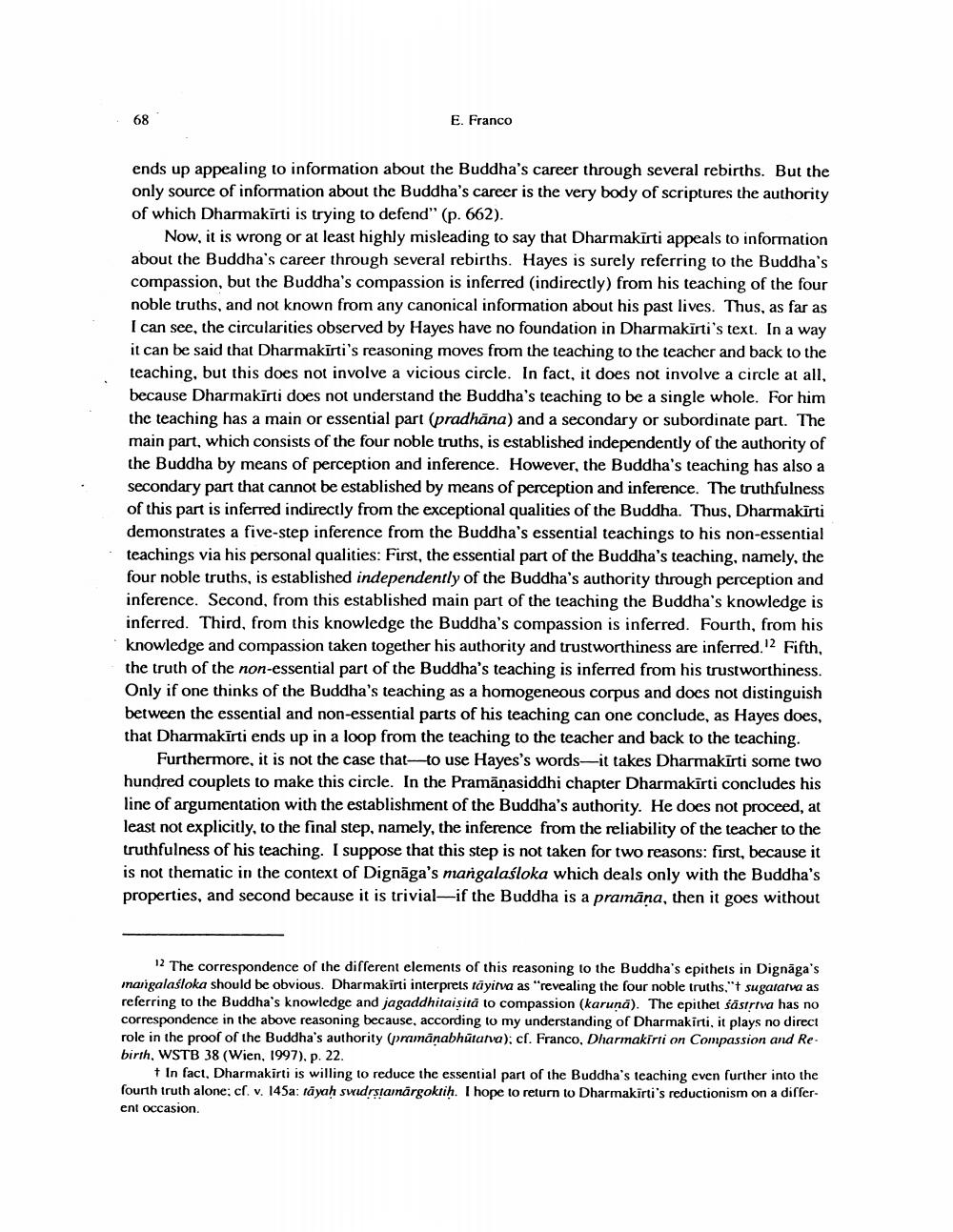Book Title: Two Circles Or Parallel Lines Author(s): Eli Franco Publisher: Eli Franco View full book textPage 6
________________ 68 E. Franco ends up appealing to information about the Buddha's career through several rebirths. But the only source of information about the Buddha's career is the very body of scriptures the authority of which Dharmakirti is trying to defend" (p. 662). Now, it is wrong or at least highly misleading to say that Dharmakirti appeals to information about the Buddha's career through several rebirths. Hayes is surely referring to the Buddha's compassion, but the Buddha's compassion is inferred (indirectly) from his teaching of the four noble truths, and not known from any canonical information about his past lives. Thus, as far as I can see, the circularities observed by Hayes have no foundation in Dharmakirti's text. In a way it can be said that Dharmakirti's reasoning moves from the teaching to the teacher and back to the teaching, but this does not involve a vicious circle. In fact, it does not involve a circle at all, because Dharmakīrti does not understand the Buddha's teaching to be a single whole. For him the teaching has a main or essential part (pradhāna) and a secondary or subordinate part. The main part, which consists of the four noble truths, is established independently of the authority of the Buddha by means of perception and inference. However, the Buddha's teaching has also a secondary part that cannot be established by means of perception and inference. The truthfulness of this part is inferred indirectly from the exceptional qualities of the Buddha. Thus, Dharmakirti demonstrates a five-step inference from the Buddha's essential teachings to his non-essential teachings via his personal qualities: First, the essential part of the Buddha's teaching, namely, the four noble truths, is established independently of the Buddha's authority through perception and inference. Second, from this established main part of the teaching the Buddha's knowledge is inferred. Third, from this knowledge the Buddha's compassion is inferred. Fourth, from his knowledge and compassion taken together his authority and trustworthiness are inferred.12 Fifth, the truth of the non-essential part of the Buddha's teaching is inferred from his trustworthiness. Only if one thinks of the Buddha's teaching as a homogeneous corpus and does not distinguish between the essential and non-essential parts of his teaching can one conclude, as Hayes does, that Dharmakīrti ends up in a loop from the teaching to the teacher and back to the teaching. Furthermore, it is not the case that to use Hayes's words-it takes Dharmakirti some two hundred couplets to make this circle. In the Pramānasiddhi chapter Dharmakirti concludes his line of argumentation with the establishment of the Buddha's authority. He does not proceed, at least not explicitly, to the final step, namely, the inference from the reliability of the teacher to the truthfulness of his teaching. I suppose that this step is not taken for two reasons: first, because it is not thematic in the context of Dignāga's mangalasloka which deals only with the Buddha's properties, and second because it is trivial—if the Buddha is a pramāna, then it goes without 12 The correspondence of the different elements of this reasoning to the Buddha's epithels in Dignāga's mangalaśloka should be obvious. Dharmakirti interprets tāyitva as "revealing the four noble truths,'t sugatava as referring to the Buddha's knowledge and jagaddhitaisitā to compassion (karuna). The epithet śästriva has no correspondence in the above reasoning because, according to my understanding of Dharmakirti, it plays no direct role in the proof of the Buddha's authority (pramanabhūtarva); cf. Franco, Dharmakirti on Compassion and Re. birth, WSTB 38 (Wien, 1997), p. 22. In fact, Dharmakirti is willing to reduce the essential part of the Buddha's teaching even further into the fourth truth alone: cf. v. 145a: täyah swidrstamärgoktih. I hope to return to Dharmakirti's reductionism on a different occasion.Page Navigation
1 ... 4 5 6 7 8 9 10
